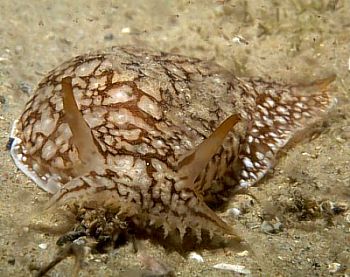
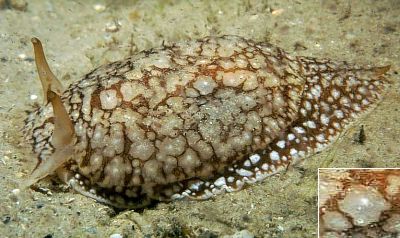
Pleurobranchaea brockii
Bergh, 1897
Order: NOTASPIDEA
Superfamily: PLEUROBRANCHOIDEA
Family: Pleurobranchidae
DISTRIBUTION
Indo-West Pacific, but few confirmed records (Japan, South Africa, eastern Australia).
PHOTO
Camp Cove, Sydney Harbour, [New South Wales, Australia] at 4m on sandy bottom, 24 February, 2000. approx 7cm long. Photos: Erik Schloegl
The mantle is translucent clear with a reticulate pattern of brown encircling the white-tipped 'mamillae' (breast-like tubercles) which cover the mantle - see inset in bottom photo. The foot is a dark brown with opaque white patches. There is a posteriorly facing dorsal spur on the posterior tip of the foot. The oral veil has about 16 ventrally projecting sensory papillae, reminiscent of the oral veil in Euselenops luniceps. Species of Pleurobranchaea are carnivorous hunters, probably eating a wide variety of prey items. Little is known of the diet of individual species although Marcus & Gosliner (1984) report finding a 65mm long (preserved?) specimen of P. brocki with 4 specimens (longest 18mm) of Philine aperta in its stomach. It grows to over 120mm long.
References:
• Bergh, L.S.R. (1897). Malacologische Untersuchungen. In: C.G. Semper, Reisen
im Archipel der Philippinen, Wissenschaftliche Resultate. Band 7, Heft 1-2
(Die Pleurobranchiden): 1-115, Pls. 1-8.
• Marcus, E. & Gosliner, T.M. (1984) Review of the family Pleurobranchaeidae (Mollusca, Opisthobranchia). Annals of the South African Museum, 93(1): 1-52.
Rudman, W.B., 2001 (March 27) Pleurobranchaea brockii Bergh, 1897. [In] Sea Slug Forum. Australian Museum, Sydney. Available from http://www.seaslugforum.net/find/pleubroc
Related messages
Pleurobranchaea brockii from Mozambique
May 30, 2008
From: Valda Fraser
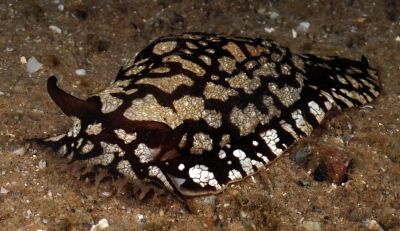

Dear Bill
Think this is Pleurobranchaea brockii. Was excited to find it on a night dive in the estuary.
Locality: Pomene, 2 m, Mozambique, Indian Ocean, 8 May 2008, Estuary. Length: 90 mm. Photographer: Valda Fraser.
Kind regards
Valda
valdafraser@mweb.co.za
Fraser, V.J., 2008 (May 30) Pleurobranchaea brockii from Mozambique. [Message in] Sea Slug Forum. Australian Museum, Sydney. Available from http://www.seaslugforum.net/find/21573
Dear Valda,
It's nice to get a record of Pleurobranchaea brockii from the western Indian Ocean. I assume you found it in the same substrate as Euselenops luniceps [message #21576]? It's a nice coincidence, because as I discuss on the species Fact Sheet, the large papillae on the underside of the wide oral veil in P. brockii are very reminiscent of the oral veil of E. luniceps, and most probably have evolved to serve the same function.
Best wishes,
Bill Rudman
Pleurobranchaea brockii - feeding observation
November 6, 2006
From: Paul Humann
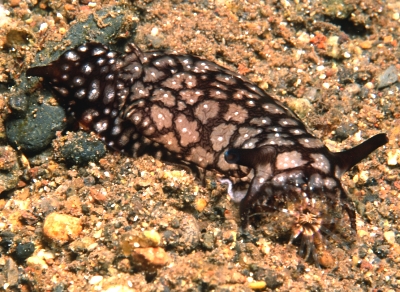
Dear Bill,
I photographed the attached Pleurobranchus off Pantar Indonesia, on a night dive in Feb. 2006. I was in 10 m of water and the Pleurobranch was
about 5cm long. It was crawling about the sand eating small tube-dwelling anemones (Ceriantharia). It would crawl to very near the anemone then lift its hood like mouth coming down over the anemone (as can be seen in the picture) before the anemone could retract. I watched this guy eat at least 4-5 of these tube anemones, no question in my mind that they were a favorite food source. Its "pounce" on them was so fast that the picture I sent was the only picture I got of it actually coming down on the anemone.
I've checked all my reference sources and all the pleurobranchs you picture on the forum, but cannot come up with an identification of the species. Do
you know what species it is? I appreciate any assistance you can give.
Keep up the good work and best regards,
Paul Humann
paulhumann@mindspring.com
Humann, P., 2006 (Nov 6) Pleurobranchaea brockii - feeding observation. [Message in] Sea Slug Forum. Australian Museum, Sydney. Available from http://www.seaslugforum.net/find/18210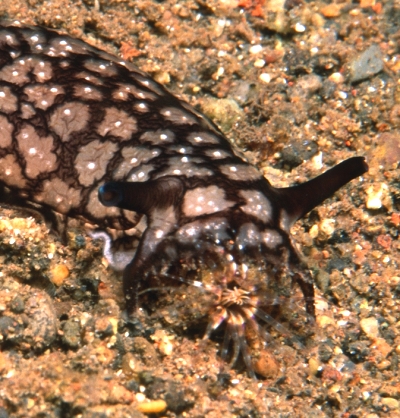
Dear Paul
This is Pleurobranchaea brockii - the feeding observation is very interesting. As you'll see on te Forum this species has been reported feeding on cephalaspidean bubble shells, and larger animals are cannibalistic. This is the first record of it feeding on sea anemones, but as anemones don't have hard parts they are not usually identified in stomach contents. We don't know much about feeding in pleurobranchs, but one species of Pleurobranchaea, P. maculata is reported to feed on anemones.
It's possible that all species of the genus are opportunistic predators, but as many potential prey do not have hard parts, we will only discover what they really eat through the accumulation of observations such as yours
Best wishes,
Bill Rudman
Pleurobranchaea brockii from Hong Kong
February 3, 2005
From: Jasmine Ng
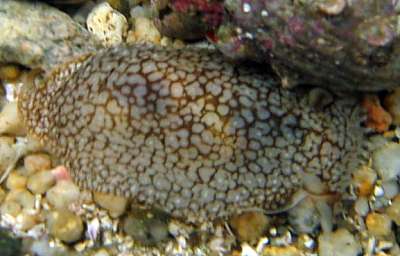
Dear Bill
I came across this species from my trawling sample in western Hong Kong
Date: 30 Dec 2003
Location: off Lantau Island, Hong Kong
Depth: < 10 m
Bottom: Rocky
The pictures showed just a small individual I've got (~ 6 cm in length; the largest ones I've got are about ~ 12 cm in length) and an egg mass from the species. Could you help with the identification of the species?
Thanks!
Regards
Jasmine
jasmine_susan@yahoo.com
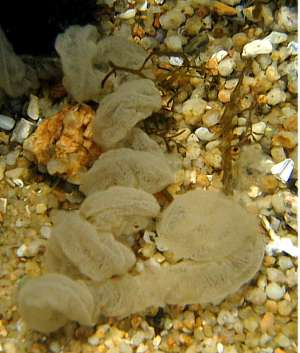
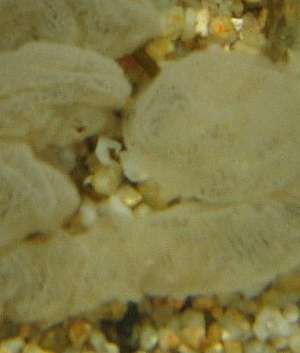
Dear Jasmine,
This is Pleurobranchaea brockii. Kathe Jensen has published a paper on feeding in this species in Hong Kong [see message #4098]. It's nice to get your photo of the egg mass of this species.
-
Jensen, K.R. (1997) Cannibalism in an opisthobranch mollusc, Pleurobranchaea brockii Bergh, 1897 from Hong Kong waters. Phuket Marine Biological Center Special Publication, 17(1): 41-46.
Best wishes,
Bill Rudman
Pleurobranchaea from the Philippine Islands
May 21, 2003
From: Erwin Köhler
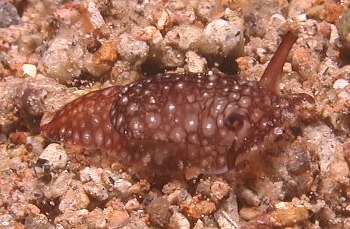
Dear Bill,
Here is another picture from the Philippine Islands.
Data:
Size 13mm
Depth 15m
Date 10 March 2003
Location: Negros Oriental Island, Lipayo
Divesite: "Dauin", nightdive
Cheers,
Erwin
Erwin@medslugs.de
Köhler, E., 2003 (May 21) Pleurobranchaea from the Philippine Islands. [Message in] Sea Slug Forum. Australian Museum, Sydney. Available from http://www.seaslugforum.net/find/9605Dear Erwin,
I am pretty sure this is Pleurobranchaea brockii. It is definitely a Pleurobranchaea but it is still a bit difficult to be sure of species identifications in this genus from photos only.
Best wishes,
Bill Rudman
Pleurobranchaea brockii? from the Philippines
November 30, 2002
From: Erwin Köhler
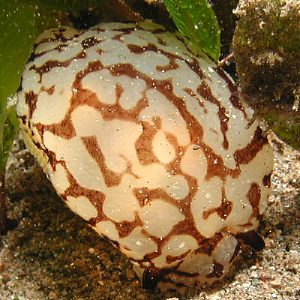
Dear Bill,
This one showed it's Pleurobranchaea-head when crawling, but when I tried to get a picture it looked as shown. I think this is Pleurobranchaea brockii. I photographed it in the Philippines, Negros Oriental Island, divesite "Dauin".
Size - 38mm
Depth - 7m
Date - 06 March 2002
Erwin
erwin@medslugs.de
Köhler, E., 2002 (Nov 30) Pleurobranchaea brockii? from the Philippines. [Message in] Sea Slug Forum. Australian Museum, Sydney. Available from http://www.seaslugforum.net/find/8515Thanks Erwin,
Photographing bashful slugs is an unfortunate occupational hazard. If only they realized they were being recorded for posterity. I agree with your identification -certainly the colour pattern fits,
Best wishes,
Bill Rudman
Daytime activity in Pleurobranchaea brockii
January 10, 2002
From: Ákos Lumnitzer
HI Bill,
Reading the comments about Pleurobranchaea brockii, I would just like to add that on August 29th, during a morning dive around Laings Point in Sydney Harbour, I found a P. brockii out and about doing its business on the sandy bottom in 4m of water.
That was my first ever sighting - no camera either, but I am dead certain of the species.
It's strange how so many nocturnal creatures can literally slap us in the back of the head and do what they are "told" NOT to do???? -that is crawl around during the day!
And to add a little more, finally I have seen and photographed (though not yet developed) Euselenops luniceps in Camp Cove last Friday night. (Jan 3 2002) We must have seen a good dozen and I even found a pair mating. Let's hope the pictures will turn out half decent so I can send them to you!
Regards
Ákos
dna72@softhome.net
Lumnitzer, A,, 2002 (Jan 10) Daytime activity in Pleurobranchaea brockii. [Message in] Sea Slug Forum. Australian Museum, Sydney. Available from http://www.seaslugforum.net/find/5913Thanks Akos,
I think Erik was just speculating that P. brockii was nocturnal rather than stating that it definitely was. Many sand dwellers do come to the surface at night - perhaps to catch their prey - but there are always exceptions to the rule especially on dull days, or when the water is murky.
Best wishes,
Bill Rudman
Re: Pleurobranchaea brockii from Sydney
April 1, 2001
From: Kathe R. Jensen
Dear Bill & Erik,
Pleurobranchaea brockii is a very common subtidal species in Hong Kong, where it grows to a considerable size (>20 cm). The larger specimens are often cannibalistic, whereas smaller individuals have been found with cephalaspids (Philinopsis cf. cyanea, Philine orientalis, Ringicula cf. doliaris) in the crop. I once found a specimen, which had eaten a smaller specimen of P. brocki, which again had Philinopsis cf. cyanea in its crop, and the Philinopsis had some Ringicula shells in its intestine. How is that for a "food chain"?
Reference: Jensen, K.R. (1997) Cannibalism in an opisthobranch mollusc, Pleurobranchaea brockii Bergh, 1897 from Hong Kong waters. Phuket Marine Biological Center Special Publication, 17(1): 41-46.
Cheers,
Kathe
jensen@ait.ac.th
Jensen, K.R., 2001 (Apr 1) Re: Pleurobranchaea brockii from Sydney. [Message in] Sea Slug Forum. Australian Museum, Sydney. Available from http://www.seaslugforum.net/find/4098Thanks Kathe,
Your 'food chain' reminds me of those nesting Russian dolls.
Best wishes,
Bill Rudman
Re: Pleurobranchaea brockii from Sydney
March 31, 2001
From: Erik Schloegl
Dear Bill,
The animal in the photographs appended to my previous message was about 7cm long, already taking into account that things appear bigger underwater. I would speculate that the reason it has been so rarely observed is that it is nocturnal, perhaps spending the day buried in the sand. Most "night" dives are conducted around sunset, while this specimen was observed quite a bit later, at least two, perhaps three hours (sorry I can't be more specific) after sunset, and I was surprised at how many different things I saw on that dive than on the usual night dives.
Best wishes,
Erik
Erik.Schlogl@uts.edu.au
Schloegl, E., 2001 (Mar 31) Re: Pleurobranchaea brockii from Sydney. [Message in] Sea Slug Forum. Australian Museum, Sydney. Available from http://www.seaslugforum.net/find/4088Thanks Erik,
Bill Rudman
Pleurobranchaea brockii from Sydney
March 29, 2001
From: Erik Schloegl


Dear Bill,
This Pleurobranchaea brockii was photographed on a night dive well after sunset at Camp Cove, Sydney, at a depth of 4m on sandy bottom on 24 February, 2000.
Best wishes,
Erik
Erik.Schlogl@uts.edu.au
Schloegl, E., 2001 (Mar 29) Pleurobranchaea brockii from Sydney. [Message in] Sea Slug Forum. Australian Museum, Sydney. Available from http://www.seaslugforum.net/find/4047Dear Erik,
This is a very interesting find. Perhaps because it seems to be a boring sandy bottom dweller, there are very few records of this species from anywhere in the Indo-West Pacific. We have a few records from around Sydney and Terry Gosliner identifies it from Spouth Africa. Apart from that there are Bergh's records from Japan.
Your nice head-on photo shows the sensory papillae on the underside of the oral veil very clearly. These are very similar to those of Euselenops luniceps, which is another sand-dwelling pleurobranch. Can you give me some imdication of size?
Best wishes,
Bill Rudman.
